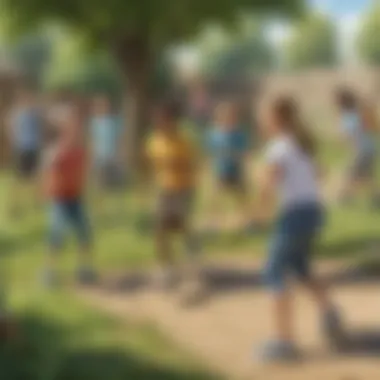Outdoor Activities for Student Engagement and Learning


Intro
Outdoor activities play a pivotal role in the educational journey of students, particularly in the elementary school age group. As children step outside, they engage with the natural environment and participate in physical activities that are not just enjoyable, but also academically beneficial. Beyond the mere act of play, these experiences foster a variety of skills, such as teamwork, problem-solving, and creativity. This article will delve into various outdoor activities specially tailored for students, highlighting their significant contributions to both educational and personal development.
The goal is to demonstrate how learning can transcend four walls and incorporate practical applications of knowledge through nature. From creative crafts inspired by the world around them to interactive quizzes that test their understanding in a fun and engaging manner, students can cultivate a well-rounded educational experience. Activities like these serve to reinforce concepts learned in a classroom while also stimulating a love for the outdoors.
As we explore these avenues, we should bear in mind the essential role parents and caregivers play in encouraging their children to engage in such enriching experiences. The following sections will provide insightful details on specific activities and their relevance in today’s learning environment. Let's begin with the exploration of creative activities.
Prelims to Outdoor Learning
Outdoor learning is a vital part of education that expands the classroom environment and incorporates the natural world. The connection between outdoor activities and educational growth is profound. Engaging students outside traditional settings fosters creativity and encourages active participation. This dynamic approach can lead to improved motivation and cognitive development.
Importance of Outdoor Activities in Education
Outdoor activities play a crucial role in the education of students. These experiences allow them to interact with their surroundings, learn through play, and build essential life skills.
- Physical Health: Being outdoors promotes physical activity. Children are more likely to engage in movement when they can run, climb, and explore, which is essential for maintaining a healthy lifestyle.
- Mental Well-being: Nature has a calming effect. Spending time in natural settings has been shown to reduce stress and anxiety in children, contributing to their overall happiness and motivation to learn.
- Social Skills: Activities like team sports and group projects require cooperation. Students learn to communicate, negotiate, and work with others, building interpersonal skills that are valuable throughout their lives.
- Cognitive Development: Outdoor learning challenges students to think critically and solve problems in real-world contexts. Encountering obstacles in nature or participating in hands-on experiments reinforces complex concepts more effectively than traditional methods.
Overview of Key Benefits
There are several key benefits associated with outdoor activities in education:
- Engagement: Learning outdoors captivates students' attention. It breaks the monotony of conventional classrooms, making education more enjoyable.
- Experiential Learning: Students learn best when they can experience concepts in practice. Outdoor activities provide opportunities for direct engagement and application of knowledge.
- Environmental Awareness: Engaging with nature fosters a sense of responsibility towards the environment. Students gain an understanding of ecological systems and their importance.
- Enhanced Learning Outcomes: Research indicates that students who participate in outdoor learning often achieve better academic results. This is due to increased motivation, improved focus, and stronger retention of information.
"Education is not preparation for life; education is life itself."
— John Dewey
Types of Outdoor Activities
Outdoor activities play a significant role in enhancing the educational experience for students. They provide practical applications of classroom lessons and encourage physical engagement. These activities can foster social skills, creativity, and a deeper connection to the environment. Understanding various types of outdoor activities is essential in creating an engaging curriculum that caters to different interests and learning styles.
Physical Activities
Sports
Sports encompass a range of structured games and competitive activities that promote physical fitness and teamwork. They encourage students to develop coordination, strength, and endurance. Sports are popular as they often encourage participation from all students, regardless of skill level. The collaborative nature of sports fosters communication and helps in building friendships. However, it is crucial to emphasize inclusivity in sports, as competition can sometimes lead to exclusion if not managed well.
Team Games
Team games focus on collaboration and communication among participants. They include classic games like soccer, basketball, or capture the flag. These games emphasize the importance of strategy and working together towards a common goal. They are beneficial because they develop not only physical skills but also important social skills like cooperation and empathy. One drawback is that students who are less athletically inclined might feel discouraged during competitive team games; thus, it is beneficial to create balanced teams to promote inclusivity.
Fitness Challenges
Fitness challenges are designed to set personal goals and achieve various physical activities, such as obstacle courses or relay races. They foster a friendly atmosphere where students can support one another in reaching their fitness targets. These challenges promote self-awareness and confidence, encouraging students to push their limits. However, it can be challenging to ensure that each student is comfortable with the level of difficulty in these activities, so modifications might be necessary to cater to varying skill levels.
Nature-Based Activities
Gardening
Gardening involves cultivating plants, flowers, and vegetables, allowing students to connect with nature hands-on. This activity teaches patience and responsibility as students care for their plants throughout different growth stages. Gardening is beneficial because it promotes environmental awareness and appreciation for ecosystems. However, it requires time and commitment, and not all students may find gardening appealing, making it essential to diversify the approach with other engaging activities.
Nature Walks
Nature walks invite students to explore their environment while learning about local flora and fauna. This activity enhances observational skills and can also be integrated with lessons on ecology and biology. The key benefit of nature walks is the immersion in a real-world setting, which can solidify knowledge gained in the classroom. One challenge might be ensuring all students can participate, as some may have mobility limitations.
Birdwatching
Birdwatching involves observing various bird species in their natural habitat. It encourages students to develop patience and enhances their observational skills. This activity promotes a deeper understanding of wildlife and encourages respect for all living things. However, it can require specific knowledge of bird species, which may necessitate some guidance and resources to engage students fully.
Creative Activities


Outdoor Art Projects
Outdoor art projects take creativity beyond the classroom walls, allowing students to express themselves in nature. Using natural materials, students can create art that reflects their surroundings, connecting artistic expression with environmental awareness. This approach encourages creativity and critical thinking. One potential downside is that weather can limit these activities, so planning is essential.
Photography Walks
Photography walks offer students the chance to capture their surroundings through their lenses. This activity heightens their awareness of details in nature and promotes creativity. Additionally, students can learn technical skills around photography while expressing their creativity. However, students may need access to cameras or smartphones, which could be a barrier for some.
Storytelling Sessions
Storytelling in the great outdoors can create a captivating atmosphere for students as they share tales inspired by their surroundings. It encourages imagination and improves verbal skills. Storytelling enhances community building among peers and can introduce cultural elements relevant to nature. The only disadvantage might be the need for a facilitator to guide the stories if students are shy.
Educational Activities
Science Experiments
Outdoor science experiments allow students to conduct hands-on investigation in real-world contexts. This application of theoretical knowledge encourages exploration and curiosity. Engaging in these experiments fosters critical thinking and problem-solving skills. However, teachers must ensure safety precautions are in place, as outdoor settings may introduce unforeseen risks.
Field Trips
Field trips offer valuable learning experiences outside of the classroom. They expose students to environments like museums, natural parks, or historic sites and allow for direct engagement with the subject matter. Field trips can strengthen the learning process by providing context and enrich classroom discussions. They can be costly and require extensive planning, which might present a logistical challenge.
Environmental Education
Environmental education focuses on teaching students about the ecosystem and the importance of conservation. This knowledge cultivates awareness and respect for nature and can inspire positive environmental behaviors. Environmental education programs can include hands-on activities, making the lessons more impactful. However, it might be challenging to incorporate this into a packed curriculum without sufficient time.
Key takeaway: Outdoor activities enhance learning experiences, promote engagement, and facilitate personal growth among students, making them critical components of education.
Implementing Outdoor Activities in School Curriculums
Implementing outdoor activities within school curriculums bridges the gap between traditional educational methods and experiential learning. It goes beyond mere physical education, incorporating elements that enhance critical thinking, creativity, and social interaction. By integrating outdoor experiences, educators can provide students with a holistic educational approach that promotes not only cognitive growth but also emotional and physical well-being.
Curriculum Integration
Integrating outdoor activities into the curriculum is essential for several reasons. Firstly, it enhances student engagement. Many students struggle with attention within conventional classroom settings. Activities outside the classroom can make learning more appealing and dynamic. For instance, conducting science experiments in a natural setting can enable students to observe real-world applications of their studies.
Additionally, it supports various learning styles. Some students learn better through hands-on experiences rather than passive listening. Outdoor activities allow for kinesthetic learning opportunities that can reinforce concepts through practice.
Furthermore, integrating outdoor activities fosters teamwork and cooperation. Group activities such as team sports or collaborative nature projects require students to communicate and work towards common goals, thereby enhancing their social skills.
Creating Outdoor Learning Spaces
Creating effective outdoor learning spaces is vital for successful implementation of outdoor activities. These spaces should be accessible, safe, and conducive to various educational experiences.
Designing Functional Areas
Designing functional areas means ensuring that outdoor settings are designed to facilitate specific learning experiences. For example, a well-planned garden can serve not only as a learning tool for botany but can also act as a space for students to engage in creative outdoor projects. A key characteristic of functional designs is versatility—the ability to accommodate different activities simultaneously or sequentially.
Such areas should include zones for physical activities, reflective spaces, and areas for collaborative tasks. A unique feature of these functional spaces is how they can promote an interactive learning environment. This allows students to experience nature directly, instilling an appreciation for the environment while enhancing their educational experience.
However, one must consider the challenge of maintenance. Outdoor learning spaces require ongoing attention to ensure they remain safe and inviting.
Safety Considerations
Safety considerations are paramount when implementing outdoor activities. Ensuring that spaces are safe helps guard against accidents or injuries, allowing students to participate confidently. A significant characteristic of safety measures includes proper equipment and appropriate site selection. Outdoor areas should be free of hazards, and equipment should meet safety standards.
Unique features of safety considerations also include training for staff and structured guidelines for students. This is critical to minimize risks effectively. While safety measures can require additional planning and resources, the advantages include increased student confidence and participation. When students feel secure, they are more likely to engage fully in their activities, fostering a more enriching educational environment.
Respiratory Health and Outdoor Activities


Outdoor activities play an essential role in promoting respiratory health among students. Engaging with nature not only provides physical benefits but also contributes positively to overall respiratory function. Fresh air helps to improve lung capacity and supports general well-being. Studies suggest regular exposure to outdoor environments enhances respiratory health, especially for young children.
Benefits of Fresh Air
Fresh air is vital for maintaining good health. When students engage in outdoor activities, they breathe in clean air, which has several benefits, including:
- Improved Lung Function: Outdoor exercise enhances lung efficiency. This can help students breathe easier and perform better during physical activities.
- Increased Physical Activity: Outdoor play encourages movement, which can lead to better heart and lung health.
- Mental Clarity: Fresh air can have a refreshing effect on the mind. Students frequently report feeling more focused and energetic after spending time outside.
- Reduced Symptoms of Stress: Being outdoors can lower stress levels, which can in turn reduce instances of respiratory distress related to anxiety.
Understanding Allergies and Outdoor Play
While spending time outside has many health benefits, it also presents some challenges, particularly for those with allergies. It is crucial for students and educators to understand these aspects to ensure a safe outdoor experience. Here are several considerations:
- Allergen Awareness: Common outdoor allergens include pollen, mold, and certain plants. Recognizing these can help students avoid discomfort.
- Timing Outdoor Activities: Engaging in outdoor activities during times when allergen counts are lower can help minimize allergy flare-ups.
- Preventative Measures: Encouraging students to take medication as prescribed and wear protective clothing can help mitigate allergic reactions while participating in outdoor activities.
- Communication: It's essential for parents and teachers to communicate about allergy management strategies before planning outdoor events.
"Engaging children in outdoor activities can significantly improve their respiratory health, provided that we also take their allergies into account."
By fostering a better understanding of respiratory health in relation to outdoor activities, educators can promote an environment that benefits all students. This dual focus on health and enjoyment is crucial for creating successful outdoor learning experiences.
Collaboration and Teamwork in Outdoor Activities
The essence of education extends beyond traditional classrooms. Collaboration and teamwork in outdoor activities offers substantial benefits for students. Engaging in these activities teaches vital social skills, fosters communication, and helps develop friendships. By working together outside, students learn to rely on each other and share responsibilities, which is essential for their personal growth.
Building Social Skills
Outdoor activities provide an excellent platform for building social skills. When students participate in team sports or group games, they face situations that require interaction. These settings are natural environments where students can practice conversation, negotiation, and conflict resolution.
- Effective Communication: Students can express their ideas, share strategies, and listen to one another during play.
- Trust Building: They learn the importance of trusting their peers. This trust leads to stronger bonds and mutual respect.
- Problem Solving: Faced with challenges, students work together to find solutions. This reinforces teamwork and collective thinking.
Involvement in collaborative outdoor settings also diminishes social barriers. Children from various backgrounds come together. They realize that most common ground exists when they share experiences, leading to deeper connections.
Encouraging Inclusion and Participation
Engaging in outdoor activities encourages inclusion among all students. Providing opportunities for everyone to take part is crucial.
- Diverse Activities: Schools can introduce a range of activities that cater to different interest levels and abilities. For instance, while some might prefer competitive sports, others may thrive in creative endeavors like outdoor art projects.
- Adapted Roles: Assigning specific roles within teams allows every student to contribute, regardless of skills. This not only boosts confidence but also promotes the value of every team member.
- Positive Environment: Creating a welcoming atmosphere is integral. When students feel valued and included, they are more likely to participate and support one another.
"Collaboration in outdoor education connects students in a manner traditional classrooms cannot achieve."
These efforts ensure that outdoor experiences contribute to holistic education. They nurture not just academic abilities but also personal development.
\
Challenges of Outdoor Activities
Outdoor activities bring significant benefits to students. However, they also come with challenges that need to be addressed for effective implementation. Understanding these challenges is crucial for educators and caregivers. It not only helps in planning successful outdoor experiences but also ensures the safety and enjoyment of all participants.
Weather Conditions
Weather conditions are one of the most unpredictable aspects of outdoor activities. Factors like rain, high winds, or extreme temperatures can disrupt plans and hinder participation. This unpredictability can create discomfort and even safety risks for students.
Adapting activities to the weather is vital. For example, if it is raining, schools might arrange indoor versions of planned outdoor games or activities. Educators can also teach students about preparing for various weather conditions. This includes wearing appropriate clothing and understanding when it is safe to be outdoors.
The benefits of understanding weather conditions include:
- Safety: Reducing risks associated with severe weather.
- Adaptability: Enhancing planning skills among students.
- Awareness: Promoting environmental education through weather discussions.
Resource Limitations
Resource limitations present another challenge in organizing outdoor activities. Not every school has access to expansive outdoor spaces or proper equipment for various activities. This can restrict the types of experiences that students can partake in.
Moreover, budget constraints can limit opportunities to engage with specialists or purchase outdoor gear. To overcome these limitations, community partnerships can be valuable. Schools can collaborate with local organizations that offer resources like equipment or outdoor spaces. Additionally, teachers can design activities that utilize the natural environment around schools, ensuring that costs remain low.
Addressing resource limitations can lead to:


- Creativity: Encouraging innovative uses of available materials.
- Community Engagement: Strengthening ties with local resources and organizations.
- Inclusivity: Ensuring all students have access to outdoor experiences, regardless of school funding.
Evaluating Outdoor Activities
Evaluating outdoor activities is an essential step in understanding their impact on education and student engagement. It allows educators to gauge the effectiveness of these activities and ensure they meet their educational goals. The evaluation process encompasses various aspects, such as assessing learning outcomes and gathering feedback from participants. Through evaluation, schools can enhance future programs, ensuring they are beneficial and align with the students’ needs.
Assessing Learning Outcomes
Assessing learning outcomes involves measuring how well students acquire knowledge and skills through outdoor activities. It can be approached in various ways:
- Observation: Teachers can observe students during activities. This helps them identify which skills are being developed. For example, a hiking exercise may improve navigation skills and teamwork.
- Quizzes and Reflections: After an outdoor activity, students can complete a quiz or write a reflection on what they learned. This self-assessment encourages them to think critically about their experiences.
- Project-Based Assessments: Engaging students in projects related to outdoor activities can also help assess learning outcomes. For instance, after a visit to a botanical garden, students might create a presentation about different plant species.
Assessing these outcomes provides valuable insights into the educational benefits of outdoor activities. It is crucial for ensuring these programs are successful in enhancing student learning.
Feedback Mechanisms
To continually improve outdoor activities, effective feedback mechanisms should be in place. Feedback from students, teachers, and parents plays a crucial role in evaluation. Here are some methods to collect feedback:
- Surveys: Simple surveys can be distributed to gather opinions about the activities. Questions can range from enjoyment levels to perceived educational value.
- Focus Groups: Small focus groups can encourage deeper discussions about what students enjoyed or found challenging during their outdoor experiences.
- Informal Discussions: Casual talks after activities can reveal immediate insights. Students might share thoughts on their favorite parts or suggest improvements.
Collecting this feedback helps create a responsive learning environment. By understanding the participants' experiences, educators can tailor future activities to better meet their needs, thereby enhancing engagement and learning outcomes.
"Understanding the impact of outdoor activities is crucial in maximizing their educational potential."
Continued evaluation ensures the longevity and efficacy of outdoor education programs, benefiting not just students but the entire school community.
Future of Outdoor Activities in Education
The future of outdoor activities in education is crucial for developing well-rounded students. With increasing awareness of health, socialization, and the importance of hands-on experiences, educators are re-evaluating conventional methods of teaching. The integration of outdoor learning into curriculums encourages a more dynamic and engaging approach to education. It shifts focus from solely academic achievements to a holistic experience that nurtures various skills and talents.
Emerging Trends
Several trends are shaping the landscape of outdoor education. First, there is a growing emphasis on sustainability. Schools are incorporating eco-friendly practices such as recycling, composting, and using native plants in outdoor spaces. This not only benefits the environment but also teaches students the importance of stewardship.
Another trend is the use of community partnerships. Schools are working with local organizations to create more enriching outdoor programs. These partnerships provide students with real-world experiences and foster a sense of community. Collaborating with environmental groups, for example, can allow students to engage in conservation projects, thus enhancing their learning.
Additionally, inclusivity is becoming a priority. Activities are being designed to accommodate students of all abilities, promoting participation and social skills among diverse groups.
Technology Integration
The integration of technology into outdoor activities offers exciting opportunities for students. Using devices like tablets and smartphones, educators can enhance learning experiences in various ways. For instance, augmented reality applications can make nature walks more interactive and educational by providing real-time information about flora and fauna.
Moreover, schools are utilizing GPS technology in many outdoor activities. Geocaching, for example, encourages students to explore their environment while learning navigation skills. This use of technology fosters teamwork and critical thinking.
"Nature and technology can coexist beautifully in educational settings, leading to richer learning experiences."
It’s important, however, to balance screen time with actual exploration. Ensuring students engage physically with nature is vital. Ultimately, the future of outdoor activities in education seems promising, with a blend of tradition and innovation shaping the experience for the better.
Applying these trends will not only enhance educational outcomes but also prepare students to face the challenges of an ever-evolving world.
Finale
The significance of outdoor activities in education cannot be overstated. As discussed, these experiences offer students a well-rounded approach to learning that goes beyond traditional classroom methods. Engaging in outdoor activities helps in improving physical health, boosting social skills, and fostering a deeper connection with the environment.
Recap of Key Points
- Outdoor activities enhance learning by providing practical applications in real-world contexts.
- They promote teamwork and collaboration, which are critical skills for students.
- Nature-based activities foster environmental awareness and appreciation.
- Creative and educational activities in outdoor settings stimulate creative thinking and problem-solving skills.
- Schools face challenges such as weather conditions and resource limitations, but addressing these can lead to better implementation of outdoor learning.
Final Thoughts on Outdoor Education
Outdoor education is crucial, especially for elementary school students. It cultivates a balance between physical and mental activities, thereby enriching children’s growth. By integrating outdoor activities within the curriculum, educators can help develop essential life skills in students. As society becomes more aware of the need for holistic education, outdoor learning continues to be a relevant and impactful approach.
"Education is not preparation for life; education is life itself."
Incorporating outdoor experiences into educational settings allows students to learn in a dynamic and engaging manner, which ultimately leads to better retention of knowledge and an appreciation of the world around them.







